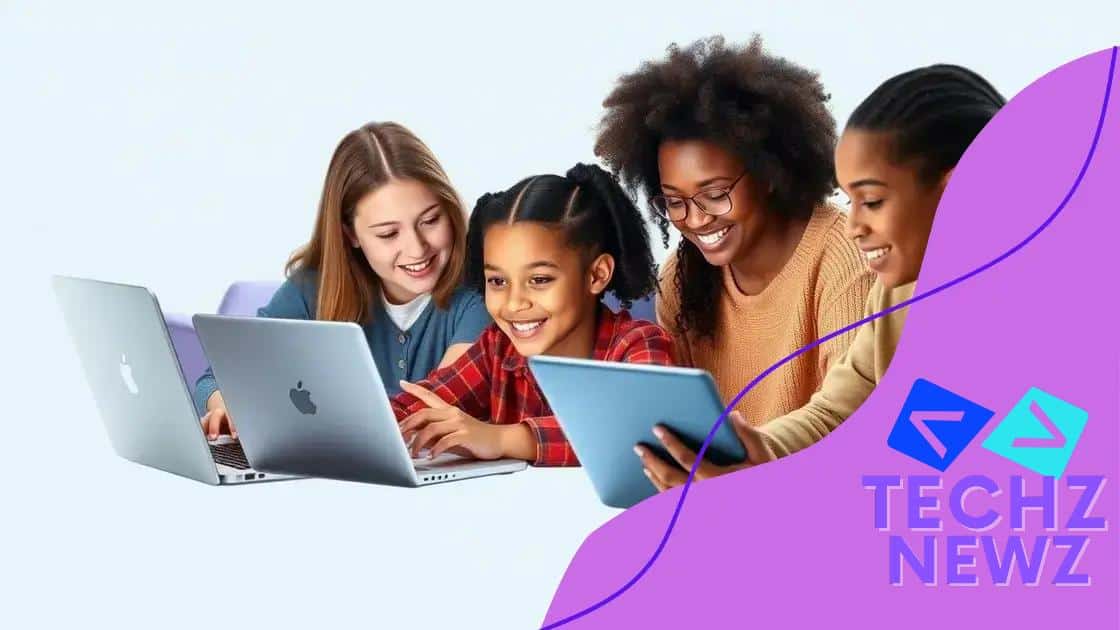The impact of virtual classrooms on student collaboration

The impact of virtual classrooms on student collaboration includes enhanced communication, access to diverse perspectives, and the development of essential skills, all while addressing challenges through effective tools and strategies.
The impact of virtual classrooms on student collaboration is more significant than many realize. As education transitions online, how does this influence how students work together? Let’s dive into the details.
Understanding virtual classrooms
Understanding the virtual classrooms concept is vital in today’s education landscape. These innovative settings allow students to learn and collaborate from anywhere using technology.
What are virtual classrooms?
Virtual classrooms refer to online learning environments where instructors and students interact in real time. These platforms provide the benefits of traditional classrooms, with added flexibility. Students can attend classes, submit assignments, and participate in discussions all from their devices.
Key features of virtual classrooms
- Real-time communication through video and chat.
- Access to recorded lectures and resources.
- Collaborative tools for group projects.
Many educational institutions have adopted virtual classrooms, especially since the recent shift toward digital learning. The accessibility of these programs makes education available to more people. This is essential for those who may have difficulties attending in-person classes due to distance or other factors.
Furthermore, the use of interactive tools has transformed learning experiences. Students can engage in discussions, participate in polls, and work together on projects in a way that mirrors face-to-face interaction. These aspects help maintain a community feeling, vital for student engagement.
Benefits of using virtual classrooms
Virtual classrooms offer numerous advantages:
- Flexibility: Students can choose their study environment.
- Cost-effective: Saves time and money on commuting.
- Increased participation: Those shy in person may find it easier to speak up online.
As education continues to evolve, understanding the impact of virtual classrooms on collaboration is essential. They not only change how students learn but also how they work together on tasks. With the right approach, these tools can enhance educational outcomes and prepare learners for the future.
Benefits of virtual collaboration
The benefits of virtual collaboration are becoming more apparent as education moves online. Students can connect and work together seamlessly, no matter where they are.
Enhanced communication
Virtual collaboration enhances communication among students. Video conferencing tools and chat platforms allow for instant dialogue. This real-time interaction helps clarify ideas and provide immediate feedback.
Access to diverse perspectives
Working in virtual teams exposes students to varied viewpoints. They can engage with peers from different backgrounds, which enriches their learning experience. This diversity fosters creativity and understanding.
- Global learning: Students can collaborate with peers worldwide.
- Increased innovation: Different ideas lead to unique solutions.
- Improved problem-solving: Group discussions often result in better outcomes.
The use of collaborative tools in virtual classrooms promotes engagement. Assignments often require teamwork, allowing students to share ideas and resources. This shared responsibility builds trust and accountability among peers.
Moreover, virtual collaboration offers flexibility in work styles. Students can engage with content at their own pace and contribute when they feel ready. This adaptability makes learning more personalized and effective.
Skill development
Engaging in virtual collaboration also develops essential skills. Students learn how to communicate effectively and manage their time. They must navigate technology and utilize various digital platforms. These skills are crucial in today’s workforce.
As students become more comfortable with virtual collaboration, they build confidence. They learn to express their ideas clearly and work within a team. This prepares them for future educational and professional endeavors, making virtual collaboration an invaluable aspect of learning.
Tools for effective online teamwork

Using the right tools for effective online teamwork can significantly enhance collaboration in virtual classrooms. With many options available, students can choose platforms that suit their needs.
Popular collaboration tools
There are several widely used tools that facilitate online teamwork.
- Google Workspace: This suite includes Google Docs, Sheets, and Slides, allowing real-time collaboration on documents.
- Microsoft Teams: A comprehensive platform for chat, video calls, and file sharing, perfect for group assignments.
- Asana: A project management tool that helps teams track their tasks and deadlines efficiently.
These tools help students communicate and share resources easily. They create an interactive environment that mirrors traditional group projects.
Benefits of using collaborative tools
Collaborative tools provide several advantages for students working together online. They allow for immediate feedback, which can enhance learning early on. Students can share ideas quickly, making the learning process more dynamic. Additionally, these platforms often have features that track changes and contributions, ensuring that everyone is accountable.
Moreover, most of these tools are accessible on various devices, allowing students to work from anywhere. This flexibility is essential for maintaining collaboration, especially when students have different schedules. They can easily log in to continue a project at their convenience.
To maximize the effectiveness of these tools, students should learn proper online etiquette. Communication is key, and understanding how to express ideas clearly in writing is crucial. Using emojis or reactions can also help convey tone.
Integrating tools into learning
Incorporating these collaborative tools into daily learning can streamline processes. Teachers can assign projects that require teamwork through these platforms, promoting an engaging learning atmosphere. This integration not only enhances cooperation among students but also prepares them for future workplaces where technology plays a significant role.
Student engagement in virtual settings
Student engagement in virtual settings is crucial for effective learning. When students participate actively, they retain information better and feel more connected.
Importance of engagement
Engagement creates a lively classroom environment, even online. When students are involved, they ask questions and share insights. This interaction enhances understanding and helps them grasp complex concepts.
Strategies to boost engagement
Teachers can use various strategies to promote student engagement:
- Interactive lessons: Utilize polls and quizzes to encourage participation.
- Group discussions: Allow students to collaborate in breakout rooms, fostering teamwork.
- Gamification: Introduce game-like elements to make learning fun and exciting.
By implementing these strategies, instructors can create a dynamic online learning experience. However, it is equally important to empower students to take charge of their learning. Encouraging them to set goals and track progress can deepen their investment in education.
Additionally, feedback plays a vital role in engagement. Regular check-ins on understanding and progress encourage students to reflect on their learning. This interaction helps them feel valued and heard, further motivating them to participate.
Leveraging technology
Technology can facilitate student engagement in virtual classrooms. Features like virtual whiteboards and shared documents allow students to contribute in real time. This involvement not only enhances their learning but also builds confidence in expressing ideas.
As educators create engaging virtual environments, students can thrive. By fostering a sense of community and interaction, they become more motivated learners. Ultimately, focusing on student engagement leads to better educational outcomes in online settings.
Challenges and solutions for online collaboration
The challenges and solutions for online collaboration are significant to consider as more students engage in virtual learning. While technology offers many benefits, there are obstacles to overcome for effective teamwork.
Common challenges
Students face several difficulties when collaborating online. Communication barriers can lead to misunderstandings and frustration. Without face-to-face interaction, discussing ideas becomes more challenging. This often results in reduced engagement.
- Technical issues: Slow internet or software problems can disrupt group work.
- Time zone differences: For global teams, finding suitable meeting times can be tough.
- Lack of accountability: Some students may not pull their weight in group projects.
These challenges can hinder productivity and limit the success of the learning experience. However, identifying solutions can help improve collaboration.
Effective solutions
To address these challenges, several effective strategies can be implemented. Establishing clear communication norms is essential. Setting expectations for responses and using collaborative tools can help students stay connected.
Additionally, educators can provide support for technical issues. Offering tutorials on platforms being used can lessen frustration. Encouraging students to reach out for help when they encounter technological challenges fosters a supportive learning environment.
One solution is to create flexible group timelines. This allows students to contribute at their convenience, accommodating various schedules. Furthermore, employing project management tools can help track progress and ensure accountability among group members.
Building a sense of community online is vital for overcoming challenges. Encouraging students to engage with one another regularly fosters trust and camaraderie. When students feel connected, they are more likely to collaborate efficiently.
In conclusion, understanding the impact of virtual classrooms on student collaboration is essential in today’s educational landscape. By recognizing the challenges and implementing effective solutions, both educators and students can enhance the online learning experience. Utilizing the right tools and fostering communication can create a more engaging and productive environment. With the right strategies, students can thrive in virtual learning settings, building skills that will benefit them in the future.
\n
\n
FAQ – Frequently Asked Questions about Virtual Classrooms and Student Collaboration
What are the main benefits of using virtual classrooms?
Virtual classrooms offer flexibility, access to diverse resources, and the ability to collaborate with classmates from anywhere, enhancing the overall learning experience.
How can teachers promote student engagement in online settings?
Teachers can use interactive tools, encourage discussions, and create group activities to foster a sense of community and increase participation among students.
What challenges do students face in online collaboration?
Common challenges include communication barriers, technical issues, and lack of accountability, which can hinder teamwork and productivity.
What solutions can improve online collaboration?
Implementing clear communication norms, providing technical support, and using project management tools can help enhance collaboration in virtual classrooms.





